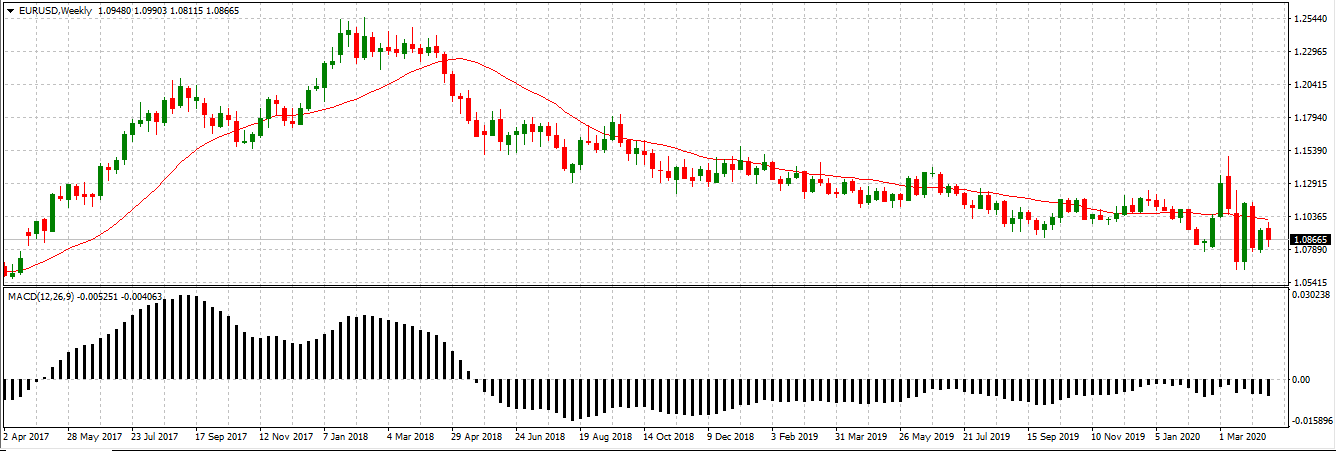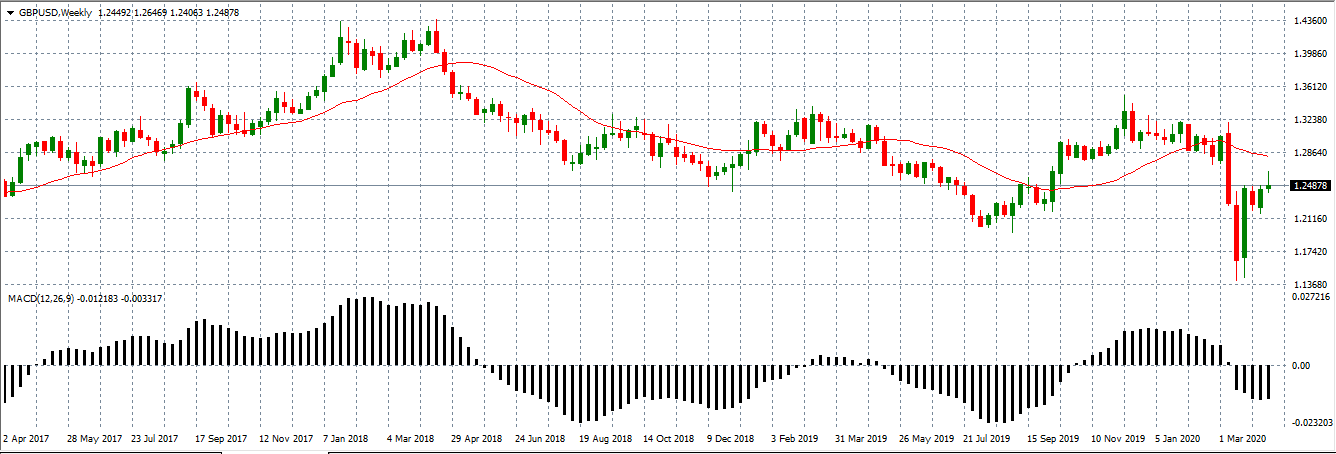Description of the OSMA Indicator for MT4
So what does the above
daily chart say about the latest developments with EUR/USD pair? As we can see this pair has gone through several stages:
- From January 2020, OSMA went negative and during the same time, Euro entered a downward trend, falling from 1.12 to 1.07 range for a period of time.
- By the later February, the single currency was on the offensive again, rising steadily and at one point piercing 1.14 mark.
- Regardless of this development, it was all short-lived. The OSMA for this pair slipped back into negative territory and EUR/USD consolidated around 1.09 level in recent times..
As long as an oscillator for the moving average stays well below zero, predicting a major trend change can be premature. So depending upon the economic data and price action, the pair might settle down for some trading range, or alternatively resume its long term downward trend.
Advantage of the OSMA Indicator for MT4
One of the most important advantages of using the MT4 OSMA indicator for beginners is that it helps them to visualize the strength of the trend. To illustrate this let us take a look at this Euro/Dollar chart:

The weekly chart above shows the long term direction of EUR/USD, combining candlesticks with the 20-week simple moving average. As we can see, by spring 2017 the OSMA indicator crossed the zero line, became positive, and kept increasing for several months until reaching extreme levels in Summer. At the same time, the Euro was in a strong uptrend, rising from $1.0600 to eventually surpassing $1.2400. This is approximately 17% appreciation against the dollar, which is a significant change.
From January to March 2018 the pair consolidated and settled for the 1.22 to 1.24 range, however during the same time OSMA started to fall consistently until going below zero marks by April 2018. From the 2nd quarter of that year, EUR/USD entered into a relatively slow, but steady downtrend with recently trading near 1.09 level. For all this time OSMA indicator remained in the negative territory, although it is slightly higher and closer to zero than a year ago.
Obviously it is difficult to tell how long the EUR/USD downtrend will continue, as we can see from the first daily chart above there was a short-lived 2-week window during March 2020, where OSMA turned positive, however, subsequently it still slipped into negative territory. As long as this state of affairs continues, it might be premature to talk about any major trench change.
So what can we learn from this example? How to use the OSMA indicator for MT4?
Well, as we can see that larger column of the OSMA chart coincided with strong trends, however, as this indicator got closer to zero both uptrends and downtrends became much weaker. It might be also helpful to mention that as OSMA turned negative in April 2018 it signaled a major trend change, which materialized during the following months.
So essentially, MT4 trading upon the OSMA Indicator provides a Forex trader with visual aids to see the direction of the currency pair and also measure the strength of the trend.
Basically, after going through the MT4 OSMA indicator tutorial, a trader can analyze charts of several currency pairs. Then he or she can select those securities where OSMA points to a clear uptrend or downtrend and trade accordingly. This indicator can also be used to predict the trend change, however, in this case, the trader must always be aware of the false signals.
Limitations of MT4 OSMA indicator strategy
Despite its impressive predicting power, the oscillator for the moving average is far from being an infallible guide for successful trading. For example in a highly volatile market, OSMA can give out false trend change signals, or alternatively downtrends or uptrends might not turn out to be as strong as this indicator might suggest. For some real-life examples of this, let us take a look at this GBP/USD weekly chart:

As we can see everything here started predictably. In the spring of 2017, OSMA overcame zero levels and steadily increased until reaching its peak by the first quarter of 2018. During the same period, GBP/USD was engaged in an uptrend from 1.2400 to eventually overcoming 1.4200 marks. As a result, the Pound appreciated by more than 14%. At this point, OSMA started to fall sharply, eventually ending up deep into negative territory in less than 3 months. At the same time, the decline of GBP/USD turned into a long term downtrend.
So as we can see so far, OSMA proved to be a very helpful predictor of market trends. However, here is the point where some interesting things happened. As 2019 began, the pair consolidated between 1.28 to 1.32 range. At the same time, OSMA started rising again, eventually crossing the zero and turning positive again. So according to everything we have seen so far, this should have signaled an end to the downtrend and beginning of the steady GBP/USD appreciation.
Despite those expectations, this currency pair collapsed, breaking down to as low as 1.21 level and as it happened, OSMA returned to negative territory. This scenario was essentially repeated in the late autumn of 2019. Here again, rising OSMA gave a false signal of the trend change, but instead, Pound collapsed once more and the long term downtrend was resumed.
As we can see from those examples above, in many cases the oscillator for the moving average can certainly be helpful for identifying trends. However MT4 trading upon the OSMA Indicator is not a 100% fail-proof solution. This indicator is sometimes susceptible to false signals.
Therefore, instead of using this measure in isolation, it might be a better idea to combine it with other technical and fundamental indicators.
Returning to our last example with the GBP/USD chart, it might seem difficult to explain why Pound fell in March 2020. After all, OSMA was increasing, there was a potential for reversal. However, if we take into account that COVID-19 concerns triggered the safe-haven trades and Bank of England slashed rates to 0.1%, then we might come up with a clearer picture.
Where can one download the OSMA indicator?
One good thing about the OSMA indicator is that traders do not need to have to pay service fees to access this information. It is not even required to open a real money trading account and make a deposit. There are several brokers who let new clients open demo accounts free of charge and download free OSMA indicators for MT4.
For example,
Axiory offers a free demo account, where a trader can use $10,000 virtual money and put trading strategies at a test without any risk of losing money. After opening the MT4 platform, one can click on the ‘indicators list’, choose ‘oscillators’, and then ‘MACD’. As a result, the OSMA histogram will appear below the traditional candlestick chart, just like we have seen in the images above. Traders are also free to make use of many other technical indicators.